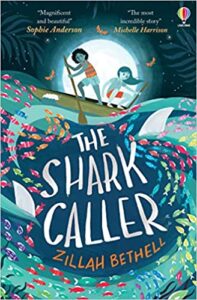Teaching SEL Lessons with ‘The Shark Caller’
By Katie Caprino
I picked up The Shark Caller by Zillah Bethell a little bit ago at a stop by one of my favorite beach bookstores. There was something about this novel’s cover that drew me in. When I opened it, I was magnetically drawn to the sea, just as Blue Wing, the story’s main character, was.

As a reader and book blogger, I absolutely loved this book. It was one of my favorite middle grades reads in a while. As a literacy professor, though, my mind starting making connections between Bethell’s The Shark Caller and socio-emotional learning (SEL).
If you want to see quick videos about SEL, you can watch CASEL’s What is Social and Emotional Learning (SEL)? or the Committee for Children’s Social-Emotional Learning: What is SEL and Why SEL Matters
In this blog post, I offer three recommendations for using The Shark Caller to engage your middle grades ELA students in SEL.
1. Consider the Importance of Naming Emotions.
Ask students to write down a list of as many emotions as they can think of. Then have them share from their own notes to create a class list of emotions. Next invite students to examine Brené Brown’s (2022) 87 Human Emotions & Experiences (see PDF on this website).
Brown’s collection is comprehensive. Students may even need to look up the definitions of some of the emotions listed! Finally have students go back to their class list and compare – taking note of what is similar and different.
It could be powerful to ask students whether they see connections to this exercise and The Shark Caller’s characters, who are exploring their own emotions. This could also lead into a discussion around why people may show emotions other than the ones they are truly feeling.
In such an exercise, students are not only thinking about the characters’ struggles with identifying their true emotions, but they are also doing some introspection about their own challenges with identifying their true emotions, which could lead to enhanced self-awareness.
2. Create “Why This Emotion?” Collages and Discuss.
I have never been quite as proud of a group of middle schoolers as when I asked my students to depict an emotion using art materials (e.g., construction paper, magazine clippings, etc.). And I only gave them five minutes!
To do this with The Shark Caller, invite students to select one of the character’s emotions to depict in a collage. Then have students share their collages with classmates. Encourage classmates to ask Why? to keep exploring characters’ multiple emotions.
For example, if a student creates a collage to depict anger, another classmate’s Why? may lead to a realization that the anger comes from sadness, which may be the result of guilt and shame, which may prompt additional Why? questions. Encourage students to support their responses to the Why? questions with evidence from the text.
Having students explain their collages to classmates helps them engage in character analysis in a way that infuses social-emotional learning. Sometimes it can be easier to speak about another’s emotions before their own.
To make this activity directly relevant to students’ emotions, you can have them do the same but with one of their emotions. This may be more appropriate when you are sure your classroom community is a safe and trusting one for all students.
3. Analyze Empathy within The Shark Caller.
Theresa Wiseman (1996) articulated the defining elements of empathy: “seeing the world as others see it,” “being non-judgemental,” “understanding another’s feelings,” and “communicating the understanding.” RSA also has a brief video in which Brown speaks about how these elements of empathy contrast with sympathy, which is an important distinction I learned much later in life than when I was in middle school.
Having students create an infographic that illuminates one instance of empathy within The Shark Caller would help students understand the text and its characters on a deeper level and also perhaps begin to consider times when they have exhibited empathy.
To connect the novel’s emotions to their own, students could then journal about a time when they showed empathy or when they could have shown empathy. This type of insight about the self may help students when they engage with their peers or family members.
There are so many possibilities with SEL-infused literacy lessons! Please let me know what you do with The Shark Caller and any other titles!
Your students might enjoy this Scrapbook created by Zillah Bethell that makes connections between The Shark Caller and her own childhood growing up in Papua New Guinea. (PDF)
References
Bethell, Z. (2021). The shark caller. London: Usborne Publishing.
Brown, B. (2022). Atlas of the heart list of emotions. Retrieved from https://brenebrown.com/resources/atlas-of-the-heart-list-of-emotions/
Committee for Children. (n.d.). Social-emotional learning: What is SEL and why SEL matters [Video]. https://www.youtube.com/watch?v=ikehX9o1JbI
CASEL. (n.d.). What is social and emotional learning (SEL)? [Video]. https://www.youtube.com/watch?v=Y-XNp3h3h4A
RSA. (n.d.). Brené Brown on empathy [Video]. https://www.youtube.com/watch?v=1Evwgu369Jw
Wiseman, T. (1996). A concept analysis of empathy, Journal of Advanced Nursing, 23, 1162-1167.
Katie Caprino is an Assistant Professor of PK-12 New Literacies at Elizabethtown College. She taught middle and high school English in Virginia and North Carolina. She holds a BA from the University of Virginia, a MA from the College of William and Mary, a MA from Old Dominion University, and a Ph.D. from the University of North Carolina at Chapel Hill.
Katie researches and presents on children’s, middle grades, and young adult literature; the teaching of writing; and incorporating technology into the literacy classroom. You can follow her on Twitter @KCapLiteracy and visit her book blog. Find Katie’s other MiddleWeb articles here.
































